• A lot of people would argue that you don't
Page 36
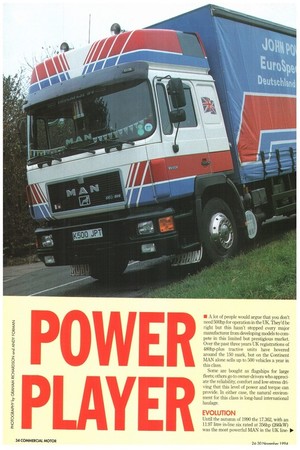
Page 38
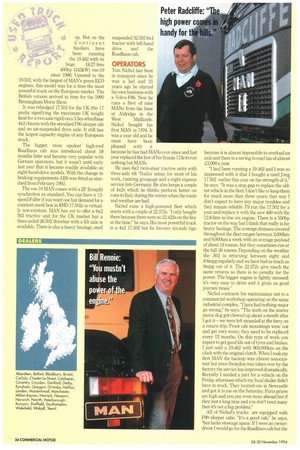
Page 39
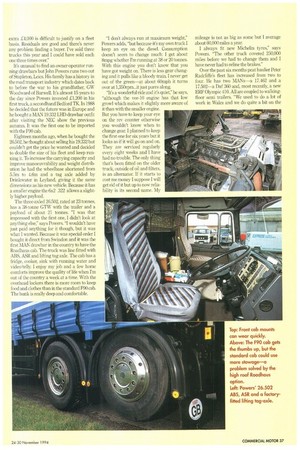
Page 40
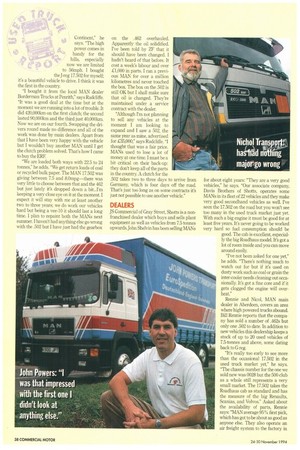
Page 41
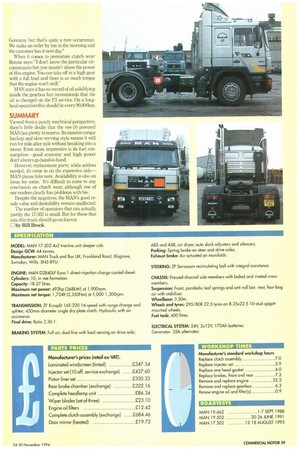
If you've noticed an error in this article please click here to report it so we can fix it.
need 500hp for operation in the UK. They'd be right but this hasn't stopped every major manufacturer from developing models to compete in this limited but prestigious market. Over the past three years UK registrations of 480hp-plus tractive units have hovered around the 150 mark, but on the Continent MAN alone sells up to 500 vehicles a year in this class Some are bought as flagships for large fleets; others go to owner-drivers who appreciate the reliability, comfort and low-stress driving that this level of power and torque can provide. In either case, the natural environment for this class is long-haul international haulage.
EVOLUTION
Until the autumn of 1990 the 17.362, with an 11.97 litre in-line six rated at 356hp (266kW) was the most powerful MAN in the UK line■ tia up. But on the
Continent Sikh hauliers have oft_ been running
the 19.462 with its huge 18.27-litre 460hp (343kW) vee-10 since 1986. Uprated to the 19.502, with the largest of MAN's green ECO engines, this model was for a time the most powerful truck on the European market. The British version arrived in time for the 1990 Birmingham Motor Show It was rebadged 17.502 for the UK (the 17 prefix signifying the maximum UK weight limit for a two-axle rigid) on a 3.5m-wheelbase 4x2 chassis with the standard F90 sleeper cab and an air-suspended drive axle. It still has the largest capacity engine of any European truck.
The bigger, more opulent high-roof Roadhaus cab was introduced about 18 months later and became very popular with German operators, but it wasn't until early last year that it became readily available on right-hand-drive models. With the change in braking requirements ABS was fitted as standard from February 1992.
The vee-10 MAN comes with a ZF Ecosplit synchrobox as standard. You can have a 13speed Fuller if you want one but demand for a constant-mesh box in RHD 17.502s is virtually non-existant. MAN has yet to offer a 6x2 502 tractive unit for the UK market but a three-axled 26.502 drawbar with a lift axle is available. There is also a heavy haulage, steel suspended 32.502 6x4 tractor with left-hand drive and the Roadhaus cab.
OPERATORS
Tom Nichol has been in transport since he was a lad and 21 years ago he started his own business with a Volvo F86. Now he runs a fleet of nine MANs from his base at Aldridge in the
West Midlands. Nichol bought his first MAN in 1976. It was a year old and he must have been pleased with it because he has had MANs ever since and last year replaced the last of his Scania 113s to run nothing but MANs.
He uses 6x2 twin-steer tractive units with three-axle tilt Trailor semis for most of his work, running groupage and a night express service into Germany. He also keeps a couple of 4x2s which he thinks perform better on runs to Italy during the winter when the roads and weather are bad.
Nichol runs a high-powered fleet which starts with a couple of 22.372s. "[only bought them because there were no 22.422s on the line at the time," he says. His most powerful truck is a 4x2 17.502 but he favours six-axle rigs
because it is almost impossible to overload an axle and there is a saving in road tax of almost £2,000 a year.
"I had been running a 19.462 and I was so impressed with it that I bought a used J-reg 17.502 earlier this year on the strength of it," he says. "It was a stop gap to replace the oldest vehicle in the fleet I don't like to keep them for much more than three years; that way I don't expect to have any major troubles and they remain reliable. I'll run the 17.502 for a year and replace it with the new 460 with the 12.8-litre in-line six engine. There is a 550hp tractor on the way but I think that really is for heavy haulage. The average distance covered throughout the fleet ranges between 3,000Icm and 6,000Icm a week with an average payload of about 18 tonnes, but they sometimes run at the full 38 tonnes. Depending on the weather the .502 is returning between eight and 8.6mpg regularly and we have had as much as 9mpg out of it. The 22.372s give much the same returns so there is no penalty for the power. The bigger engine is lightly stressed: it very easy to drive and it gives us good journey times."
Nichol contracts his maintenance out to a commercial workshop operating on the same industrial complex. "I have had nothing major go wrong," he says. "The teeth on the starter motor dog got chewed up about a month after I got it—we were left stranded at the ferry on a return trip. Front cab mountings wear out and get very noisy; they need to be replaced every 12 months. On this type of work you expect to get good life out of tyres and brakes. I just sold a 19.462 with 900,000km on the clock with the original clutch. When I took my first MAN the backup was almost non-existent but since Swindon was taken over by the factory the service has improved dramatically. Recently I needed a part for a vehicle on the Friday afternoon which my local dealer didn't have in stock. They located one in Newcastle and got it to me on the Saturday. Parts prices are high and you pay even more abroad but if they last a long time and you don't need many then it's not a big problem."
All of Nichol's trucks are equipped with F90 sleeper cabs. "It's a good cab," he says, but lacks stowage space. If I were an ownerdriver I would go for the Roadhaus cab but the extra £4,000 is difficult to justify on a fleet basis. Residuals are good and there's never any problem finding a buyer. I've sold three trucks this year and I could have sold each one three times over."
It's unusual to find an owner-operator running drawbars but John Powers runs two out of Stapleton, Leics. His family has a history in the road transport industry which dates back to before the war to his grandfather, GW Woodward of Barwell, It's almost 15 years to the day since Powers invested .1,200 in his first truck, a secondhand Bedford TK. In 1988 he decided that the future was in Europe and he bought a MAN 19.332 LHD drawbar outfit after visiting the NEC show the previous autumn. It was the first one to be imported with the F90 cab.
Eighteen months ago, when he bought the 26.502. he thought about selling his 19.332 but couldn't get the price he wanted and decided to double the size of his fleet and keep running it. To increase the carrying capacity and improve manoeuvrability and weight distribution he had the wheelbase shortened from 5.5m to 4.6m and a tag axle added by Drinkwater in Leyland, giving it the same dimensions as his new vehicle. Because it has a smaller engine the 6x2 .322 allows a slightly higher payload.
The three-axled 26.502, rated at 23 tonnes, has a 38-tonne GTW with the trailer and a payload of about 21 tonnes. "I was that impressed with the first one, I didn't look at anything else," says Powers. "I wouldn't have just paid anything for it though, but it was what I wanted. Because it was special order I bought it direct from Swindon and it was the first MAN drawbar in the country to have the Roadhaus cab. The truck was line fitted with ABS, ASR and lifting tag axle. The cab has a fridge, cooker, sink with running water and videoltelly. I enjoy my job and a few home comforts improve the quality of life when I'm out of the country a week at a time. With the overhead lockers there is more room to keep food and clothes than in the standard F90 cab. The bunk is really deep and comfortable. "I don't always run at maximum weight," Powers adds, "but because it's my own truck I keep an eye on the diesel. Consumption doesn't seem to change much: I get about 8mpg whether I'm running at 38 or 20 tonnes. With this engine you don't know that you have got weight on. There is less gear changing and it pulls like a bloody train. I never get out of the green—at about 60mph it turns over at 1,35Orpm...it just purrs along.
"It's a wonderful ride and it's quiet," he says, "although the yee-10 engine has that low growl which makes it slightly more aware of it than with the smaller engine. But you have to keep your eye on the rev counter otherwise you wouldn't know when to change gear. I planned to keep the first one for six years but it looks as if it will go on and on. They are serviced regularly every eight weeks and I have had no trouble. The only thing that's been fitted on the older truck, outside of oil and filters, is an alternator. If it starts to cast me money I suppose I will get rid of it but up to now reliability is its second name. My mileage is not as big as some but I average about 60.000 miles a year.
I always fit new Michelin tyres," says Powers. "The other truck covered 250,000 miles before we had to change them and I have never had to reline the brakes."
Over the past six months peat haulier Peter Radcliffe's fleet has increased from two to four. He has two MANs—a 17.462 and a 17.502—a Daf 360 and, most recently, a new ERE.' Olympic 410. All are coupled to walkingfloor semi trailers. "We used to do a lot of work in Wales and we do quite a bit on the Continent," he says. "The high power comes in handy for the hills, especially now we are limited to 56mph. I bought the Reg 17.502 for myself; its a beautiful vehicle to drive. I think it was the first in the country "I bought it from the local MAN dealer Borderman Trucks at Penrith," says Radcliffe. "It was a good deal at the time but at the moment we are running into a lot of trouble. It did 420,000km on the first clutch; the second lasted 90,000km and the third just 40,000km. Now we are on our fourth. Swapping the drivers round made no difference and all of the work was done by main dealers. Apart from that I have been very happy with the vehicle but I wouldn't buy another MAN until I get the clutch problem solved. That's how! came to buy the ERF.
"We are loaded both ways with 22.5 to 24 tonnes," he adds. "We get return loads of coal or recycled bulk paper. The MAN 17.502 was giving between 7.5 and 8.0mpg—there was very little to choose between that and the 462 but just lately it's dropped down a bit...I'm keeping a very close eye on it at the moment. I expect it will stay with me at least another two to three years; we do work our vehicles hard but being a vee-10 it should last a long time. I plan to repaint both the MANs next summer. I haven't had anything else go wrong with the .502 but I have just had the gearbox on the .462 overhauled. Apparently the oil solidified. I've been told by ZF that it should have been changed. I hadn't heard of that before. It cost a week's labour and over £1,000 in parts. I ran a previous MAN for over a million kilometres and never touched the box. The box on the .502 is still OK but I shall make sure that oil is changed. They're maintained under a service contract with the dealer.
"Although Pm not planning to sell any vehicles at the moment I am looking to expand and I saw a 502, the same year as mine, advertised for ,£35,000," says Radcliffe. "I thought that was a fair price. MANS used to lose a lot of money at one time. I must be a bit critical on their back-up: they don't keep all of the parts in the country. A clutch for the .502 takes two to three days to arrive from Germany, which is four days off the road. That's just too long as on some contracts it's just not possible to use another vehicle."
DEALERS
JS Commercial of Gray Street, Shotts is a nonfranchised dealer which buys and sells plant equipment as well as vehicles from 7.5 tonnes upwards. John Shelvin has been selling IVIANs for about eight years: "They are a very good vehicles," he says. "Our associate company, Davis Brothers of Shotts, operates some MANs in its fleet of 22 vehicles and they make very good secondhand vehicles as well. I've seen the 17.502 on the road but you won't see too many in the used truck market just yet. With such a big engine it must be good for at least five years. It's never going to be worked very hard so fuel consumption should be good. The cab is excellent, especially the big Roadhaus model. It's got a lot of room inside and you can move around easily.
"I've not been asked for one yet," he adds. "There's nothing much to watch out for but if it's used on dusty work such as coal or grain the inter-cooler needs cleaning out occasionally. It's got a fine core and if it gets clogged the engine will overheat."
Rennie and Nicol, MAN main dealer in Aberdeen, covers an area where high powered trucks abound. Bill Rennie reports that the company has sold a number of .462s but only one .502 to date. In addition to new vehicles this dealership keeps a stock of up to 20 used vehicles of 7.5.tonnes and above, some dating back to Greg.
"It's really too early to see more than the occasional 17.502 in the used truck market yet," he says. "The chassis number for the one we sold new was 0028 but the 500 club as a whole still represents a very small market. The 17.502 takes the Roadhaus cab as standard and has the measure of the big Renaults, Scanias, and Volvos," Asked about the availability of parts, Rennie says: "MAN average 95% first pick, which has got to be about as good as anyone else. They also operate an air freight system to the factory in Germany but that's quite a rare occurrence. We make an order by ten in the morning and the customer has it next day."
When it comes to premature clutch wear Rennie says: "1 don't know the particular circumstances but you mustn't abuse the power of this engine. You can take off in a high gear with a full load and there is so much torque that the engine won't stall."
MAN says it has no record of oil solidifying inside the gearbox but recommends that the oil is changed on the F3 service. On a longhaul operation this should be every 90.0(X)km.
SUMMARY
Viewed from a purely mechnical perspective, there's little doubt that the vee-10 powered MAN has plenty in reserve. Its massive torque backup and slow revving style means it will run for mile after mile without breaking into a sweat. Even more impressive is its fuel consumption—good economy and high power don't always go hand-in-hand.
However, replacement parts, while seldom needed, do come in on the expensive side— MAN please take note. Availability is also an issue for some. It's difficult to come to any conclusion on clutch wear, although one of our readers clearly has problems with his.
Despite the negatives, the MAN's good resale value and desirability remain unaffected.
The number of operators that can actually justify the 17.502 is small. But for those that am, this truck should go on forever.
by Bill Brock






































































































